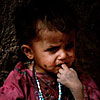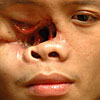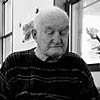 |
→ October 2006 Contents → Dispatches
|
|
|
||||||||||
|
||||||||||
EDITOR'S NOTE: 
In October Dispatches is pleased to present pieces written by photographers of many nationalities—American, English, French, Israeli and Scottish—on a wide variety of topics. Three of these came directly out of last month's Visa Pour l'Image gathering of photojournalists in Perpignan, France.
This column appears thanks to the generosity of Canon and this year at Perpignan they awarded the Canon Prize for Young Female Photographer of the Year to French photographer Véronique de Viguerie whose work has appeared here previously. Her work on the Kushi nomadic tribe is at once ambitious and dangerous.
Kushis are an ancient tribal people who in early times traveled from India to Iran. The modern creation of international borders obstructed their nomadic way of life. Now they move between Pakistan and Afghanistan. They have been traders "since the start of the Earth," as she wrote. As traders they have helped the Taliban by carrying arms from Pakistan to Afghanistan and bringing opium back to Pakistan. Land mines laid during the current war have taken a toll on their numbers. Contemporary borders and decisions also played a decisive role in the removal of Jewish settlers in Gaza.
Shaul Schwarz received the prestigious Visa d'Or at Perpignan for his work on the Israeli disengagement from Gaza. He has covered the situation in Gaza for the last eight years—although the Visa d'Or portfolio concentrated on the years 2004 - 2006 and four images from that series appear here. An Israeli photographer, Schwarz covers news from around the world. Based in New York, he felt that he could look at the trauma with an outsider's eyes and an insider's knowledge.
While at Visa I shared a cab with Jeremy Sutton-Hibbert one evening (too many potential passengers and too few taxis). Two weeks later he sent an e-mail identifying himself as the "cheeky Scottish photographer." Now based in Tokyo, he has been documenting the lives of the roma (gypsies) in Sintesti, Romania, since 1990. He wrote to say he was about to attend a roma wedding of two children during the upcoming weekend. The bride, Garoafa, is now 14 years old (the groom is 13). He had taken photographs of her throughout her young life. Looking through his earlier black-and-white photography one can see the transition of the group from poverty to property thanks to their scrap metal trade.
Included in the Sutton-Hibbert dispatch is a link to a large selection of the roma pictures. Links such as this appear with many articles this month and previously. They provide the visitor with a range of a photographer's work. Please take advantage of this and consider the breadth and depth of the work.
Mike Fox submitted one story about three months ago and waited patiently while TDJ concentrated on the Lebanon-Israel-Gaza war. The time was well spent because he decided to submit a second piece that we publish here. Fox chronicles his self-assigned project on senior citizens living at the Veteran's Hospital in Yountville, Calif. Being English and not a member of the armed services, he has been escorted throughout the complex during the last year but this did not discourage him either—he took full advantage of the Public Information Officer's knowledge of the old soldiers' circumstances.
As a photojournalist, commercial photographer and teacher, he provides insight into the work of young photojournalists and urges all photographers to take time to build relationships to achieve a fuller understanding of the subject.
There are certainly instances where time is of the essence—indeed, a lengthy exploration can be not only dangerous but also fatal. Roger Arnold's experience is a case in point. Arnold who often works in Southeast Asia, became "obsessed," he says, with the CIA's "Secret War" in Laos during the undeclared Vietnam War. The Hmong guerrillas had assisted the U.S. during the war and their descendents are still considered rebels in Laos and are stalked and killed by the government. His exclusive coverage was featured recently in Le Figaro. As a result of his images and attempt to help the Hmong, his life has been threatened and he has withdrawn into cyberspace.
All these dispatches display the photographers' commitment to their subjects, perseverance and, in some cases, bravery. If anyone is still tempted to think photojournalism is easy, quick and painless—they should read all of these stories again. Marianne Fulton |
||||||||||
Go to the Dispatches archiveBack to the Contents Page |
||||||||||




